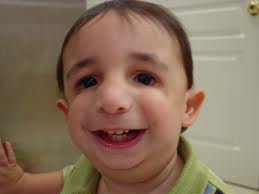Posts Tagged ‘treacher collins syndrome causes.’
“Treacher Collins syndrome”
Posted on: April 24, 2011
What is Treacher Collins syndrome?
Treacher Collins syndrome or TCS (also known as Treacher Collins-Franceschetti syndrome or mandibulofacial dysostosis) is a genetic disorder.
Causes and risk factors
Recent research has pinpointed the cause of Treacher Collins syndrome as a problem with a gene on chromosome 5.
This gene controls development of the bones and other structures of the head and neck. When the gene is faulty, the facial bones don’t develop as they should in the womb and a baby is born with characteristic facial features. The extent of these abnormalities varies from person to person, but they often cause problems with hearing, breathing and eating.
Although most children with Treacher Collins syndrome pass developmental milestones, such as starting to walk and talk, at the usual time and are of normal intelligence, hearing problems can interfere with learning. Many need help such as specialised hearing aids or speech therapy to develop speech and language.
About one in every 10,000 babies is born with Treacher Collins syndrome. The condition is dominantly inherited, which means an affected person has a 50 per cent chance of passing it on to their offspring. Many affected people can trace the condition back through their parents and grandparents. However, children who are severely affected may have a parent who is only mildly affected and vice versa, so the condition may have gone unrecognised.
In about 60 per cent of cases there’s no family history and the condition is due to a new mutation of the gene. In such cases, there’s only a tiny chance that a second child with the condition will be born to the parents, but the affected child may pass the syndrome on to their own children.
Symptoms
The following are characteristic features of Treacher Collins syndrome:
- eyes that slant down at the outer corners
- notched lower eyelids (coloboma)
- small lower jaw, which may slant
- cleft palate
- unusually large mouth
- underdeveloped, malformed or missing ears
- underdeveloped or missing cheekbones and side wall/floor of the eye socket
- large, beak-like nose
- small or obstructed nasal passages
- unusual hairline, with hair growing across the cheek like a sideburn
- occasionally, very small or missing thumbs..
Treatment and recovery
As a genetic condition, Treacher Collins syndrome can’t be ‘cured’. However, most people are able to lead completely normal lives, although many need help to cope with a variety of practical problems.
Most children with the syndrome have substantial hearing loss, for example, and may need to wear a conductive hearing aid or have implanted hearing aids.
A tracheostomy (a hole into the trachea through the front of the neck) may be needed to help breathing, while reconstructive surgery may be necessary to correct a cleft palate. A notch, or coloboma, in the lower eyelid may cause the eyes to dry out easily, increasing the risk of infection. This may require surgery.
Reconstructive surgery may also be offered to build up the cheekbones, correct the nose or an underdeveloped jaw (which may help to improve breathing) or reconstruct the outer ear.

Overcrowded teeth or malocclusion of the bite (where teeth don’t meet each other as they should) may require dental work.